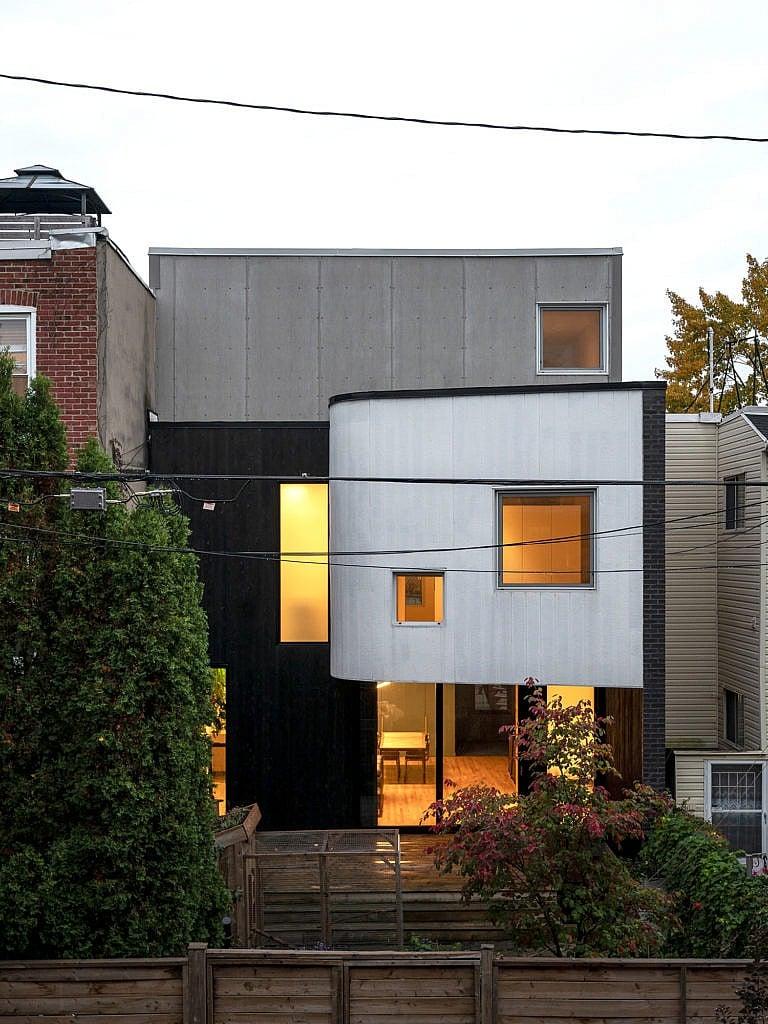This revamped ’30s-era Montreal duplex has its own Escher-inspired staircase
The Brunique family wanted a modern family home. They got it—plus a custom staircase inspired by Dutch artist M.C. Escher’s mind-bending design

Share

As a long-time advertising director and copywriting professor at the Université de Montréal, Frederic Brunique knows that realizing a creative vision takes time—sometimes a lot of it. This level of patience was useful during the nine-year renovation of his family’s 1930s duplex in Montreal’s Rosemont-La-Petite-Patrie borough, which he and his wife, Geneviève Duchesne, purchased for $350,000 in 2012. When they moved in, the property was carved into two distinct 800-square-foot, two-bedroom apartments, previously rented out to tenants.
The couple was keen to re-work the space—last renovated around the ’50s or ’60s— into a bright, modern layout in which to raise their school-aged daughters. They turned to local residential-architecture studio Naturehumaine, led by owner Stéphane Rasselet, to bring their vision to life. “Frederic wanted the architecture to have some strong idea behind it,” Rasselet says. “Something wild and out of the ordinary.”

With this freedom in mind, Rasselet proposed that the reno revolve around a dramatic central feature—in this case, a grand, functional yet sculptural staircase that echoed the topsy-turvy design of “Relativity,” a labyrinthine lithograph by Dutch artist M.C. Escher. Frederic and Geneviève jumped at it, an enthusiasm which initially surprised Rasselet. “All those stairs are a bit scary, so I probably wouldn’t have raised super-young kids in that house,” Brunique says. “But it’s perfect for my now-teenagers.”

Rasselet chose to construct the staircase from curved pieces of hot-rolled steel, giving its panels a textured appearance that complements the staircase’s overall zig-zag structure—and contrasts with the otherwise neutral palette of the home. (A local metal welding company prepared the panels.) The finished staircase ascends from the ground floor to the home’s second level, culminating at the mezzanine, which houses Brunique’s home office. From different vantage points in the house, the singular structure appears to be three separate staircases. As a final touch, Rasselet installed a skylight to crown the stairs, allowing natural light to highlight his masterpiece.
The Escher-esque staircase may be the home’s main attraction—Rasselet says Brunique’s home is one of his firm’s “more theatrical” projects—but the entire interior was gutted to make room for new features. The team at Naturehumaine also built out a cantilever bridge on the home’s second floor, creating a new hallway between Brunique’s daughters’ rooms and the primary suite, built for additional privacy. Meanwhile, on the main floor, a new combined kitchen, living and dining area is a hub of activity. “We have long desks where the girls can do their homework, while my wife and I cook dinner,” he says.

Both die-hard plant lovers, one of the couple’s favourite additions is a 20-foot vertical garden, crafted by Montreal’s Ligne Verte. The green wall, which stretches from the kitchen counter up to the mezzanine, includes 10 different species of plants, like rhododendrons, palms and various cacti, all flooded with sunlight courtesy of the home’s new skylight. The towering garden provides a soothing backdrop to family dinners, plus a pop of tropical ambiance during Montreal’s notoriously frigid winter months.
Brunique says, while the entire family is pleased with the results of the reno, it was particularly beneficial for one of his daughters, who is currently pursuing an architecture degree “Last semester, she had one assignment that asked her to analyze different residential interiors,” he says. “The professor included ours.”